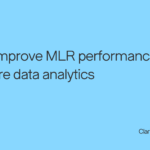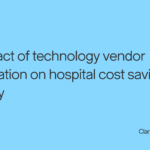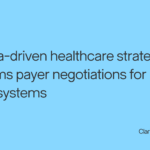Healthcare Unbound episode recap: Artificial Intelligence (AI) is a buzzword in almost every industry, promising to revolutionize our lives — for better or worse. It is emerging as a paradigm shift in healthcare with opportunities and challenges for physicians, administrators, and leaders. But what does the future of AI in healthcare look like, and how can healthcare leaders move beyond the hype and translate the potential of AI into strategic advantages for their organizations? As Todd points out, that’s not just the million-dollar question —it’s the trillion-dollar question. And how do you ensure that individuals get access to the most appropriate care in the most efficient way? “That’s where the emerging technologies [like] generative AI and large language models are unlocking what I refer to as the missing Rosetta Stone,” he explains. “Taking an incredibly complex system and decoding it … to provide guidance to those either delivering healthcare, supporting those that are delivering frontline healthcare or allocating the resources to do so.” Todd joined Saul Marquez for an episode of Healthcare Unbound to talk about how generative AI can help improve healthcare outcomes and what we can all do to understand AI while it continues to shape our world. Todd launched Clarify Health with Dr. Jean Drouin in 2015. When Todd and Jean started working together, their initial premise was to work with data assets that were becoming more widely available. Many healthcare organizations began to share data in de-identified, fully HIPAA-compliant ways so data scientists could categorize and analyze various facets of healthcare. For Clarify, that meant tracking longitudinal patient journeys (the start-to-finish care experience, including diagnosis, treatments, and recovery) and identifying positive and negative variations. The AI space is an “exciting frontier,” allowing healthcare professionals to deliver on the promise of accessible, efficient, quality care, he adds. Generative AI is a particularly useful tool to optimize large healthcare datasets, identify patterns, and find the best evidence-based recommendations at any given time, whether they’re driven by cost savings or desired outcomes. It offers enormous potential for addressing the misappropriation of resources in the healthcare system. “We want to make sure that those dollars are being used most effectively and efficiently. And we want to make sure the healthcare individuals need and deserve is most appropriately allocated to them,” Todd noted, which is all part of Clarify Health’s mission. Todd points out that the fundamental underpinning of any good optimization solution is benchmarking. “First, you have to understand the historical utilization and outcomes of any services. Across any industry, good baselining and benchmarking are the cornerstones of driving improvement. Once you have that foundation, it’s a matter of digging in and identifying the patterns of care that lead to better or more appropriate, efficient utilization of services and, therefore, outcomes.” Clarify Health uses data science techniques, including traditional machine learning and random forest modeling to create case-mix adjustment, which is essentially a way to compare a category (or categories) of data to a benchmark. In this case, it’s the health outcomes of patients cared for by a particular physician compared to overall average outcomes. Todd explains the concept this way: “Absent the treatment effect of the physicians themselves, if an average physician had treated this patient population, what would we have expected the utilization and outcomes to be? Then you can layer in the actual care provider themselves, and you can say, ‘Okay, the modeling is saying that this physician reduced utilization of nursing facility stays in total joint replacements’ — by two basis points or by two percentage points relative to the benchmark.” Clarify Health has assembled both observed and synthetic benchmarks on hundreds of millions of individuals and billions of patient journeys and asks, “Now, what can we unlock?” In recent years, we’ve seen a transformation in the healthcare industry. Physicians, executives, and shareholders alike have been embracing value-based care delivery models. Todd says behavioral incentives are a big part of the shift toward value-based care. “We talk a lot about the ills of fee-for-service, and I try not to go down that path. Instead, what I like to talk about is rewarding and incentivizing care providers like any other industry rewards and incentivizes those that outperform or perform in the ways we’re asking or expecting them to perform.” He points out that in a fee-for-service environment, people get paid for activity, not utilization and outcome. But “…the lexicon doesn’t exist to definitively say, with peer-reviewed support for the work, that one decision is more beneficial and more efficient to a patient cohort than another decision.” Therefore, incentivizing clinicians to make informed decisions with integrity throughout their patients’ journeys is a way to validate those choices with evidence on a massive scale across specialties and across patient cohorts. Clarify IQ is a conversational interface that allows users to explore and understand data, compare outcomes, and make informed decisions. “Clarify IQ unlocks the power that sits inside Clarify’s platform,” Todd explains, adding that the data asset (and the technology he and his team built with it) are collectively called Clarify Atlas. “Clarify IQ essentially allows users to read Atlas and understand where they need to go next or where they can go next,” he adds. Because the initial release of Clarify IQ sits on top of No Surprises Act (price transparency) data, healthcare professionals can use the tool to interrogate literally petabytes of data that can help them make better decisions about getting paid for the services they render or how payers will remunerate care providers. Mr. Gottula calls it “an incredibly exciting first foray into adding a conversational, optimization-focused user experience” — one that anyone can do without specialized coding or data analysis. What might a physician or a healthcare administrator ask Clarify IQ? Mr. Gottula gives a hypothetical example: If he was the contracting manager at a physician group going into rate negotiations with a payer, he could use Clarify IQ to find out what organizations have been paid for similar services by that payer in his own region as well as nationally. He could also ask Clarify IQ to analyze how his outcomes relate to how others are being paid. “Clarify IQ gives the user the ability to understand … what others are being paid, know how their performance compares to others, and be able to create a synthesis of the specific service codes … and what they should negotiate,” he says. That’s on the provider side. On the payer side, an insurance administrator might want to know about existing service providers in a given market, how they’re being paid by other payers now, and how to set the payer’s rate structure most equitably. “It’s not about minimizing payment,” Todd notes. “It’s about … setting up a tiered rate card to ensure the highest performing providers in a geography are being rewarded for the work that they’re doing.” Curious (or nervous) about AI and its potential? It’s critical to actively engage with as many AI tools and platforms as possible. Especially at this transformative stage, learning a bit about the conventions and capabilities of generative AI will go a long way toward comfortability with this technology — because it will soon be everywhere. “I said this to my parents and to my brother, who’s a high school English teacher: You need to start playing with tools like Bard. Get a ChatGPT Plus account — it’s $20 a month — and literally just start asking questions and getting yourself familiar with what is on the horizon because this isn’t just about healthcare,” Todd added. “Every industry is going to be disrupted in a positive way. It’s going to change the way we work with information.” This article is based on an episode of the Healthcare Unbound podcast, which provides front-row access to healthcare visionaries discussing advancements and groundbreaking solutions — subscribe for free and get future episodes delivered to your preferred platform. Generative AI: The New Frontier in Healthcare Technology
Big data, monumental ideas
How is AI used in healthcare: Benchmarks and case-mixes
The rise of value-based care — and the role of incentives
Meet Clarify IQ: The benefits of AI in healthcare
The future of AI in healthcare — and beyond
- Author Details





